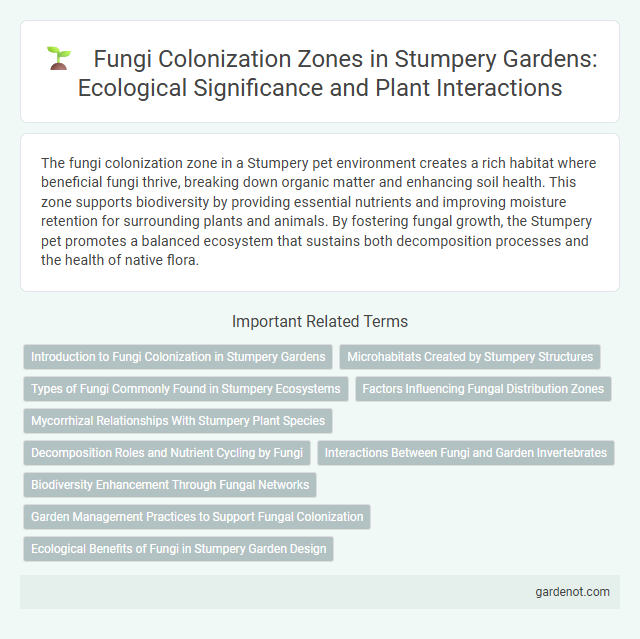The fungi colonization zone in a Stumpery pet environment creates a rich habitat where beneficial fungi thrive, breaking down organic matter and enhancing soil health. This zone supports biodiversity by providing essential nutrients and improving moisture retention for surrounding plants and animals. By fostering fungal growth, the Stumpery pet promotes a balanced ecosystem that sustains both decomposition processes and the health of native flora.
Introduction to Fungi Colonization in Stumpery Gardens
Fungi colonization in stumpery gardens plays a crucial role in decomposing wood and recycling nutrients, fostering a rich biodiversity. The unique environment of decaying stumps and logs provides an ideal habitat for various fungal species, which in turn supports soil health and plant growth. This natural process enhances the aesthetic and ecological value of stumperies, making them dynamic habitats for fungi and other organisms.
Microhabitats Created by Stumpery Structures
Stumpery structures create diverse microhabitats that enhance fungi colonization by offering shaded, moist environments ideal for mycelium growth. The intricate layering of wood and bark in stumperies fosters a rich substrate that supports various fungal species, promoting biodiversity. These microhabitats also facilitate nutrient cycling and symbiotic relationships between fungi and surrounding plant roots.
Types of Fungi Commonly Found in Stumpery Ecosystems
Stumpery ecosystems commonly host fungi such as wood-decay species like Trametes versicolor, Ganoderma applanatum, and Stereum hirsutum, which play crucial roles in decomposing deadwood and recycling nutrients. Mycorrhizal fungi, including species in the genera Russula and Lactarius, form symbiotic relationships with surrounding plants, supporting forest health and biodiversity within the stumpery. These fungi-rich microhabitats foster complex fungal communities that enhance soil fertility and contribute to the overall ecological balance in woodland gardens.
Factors Influencing Fungal Distribution Zones
Fungi colonization zones in stumperies are primarily determined by factors such as moisture levels, substrate composition, and microclimatic conditions. Variations in decaying wood species, pH balance, and nutrient availability significantly influence fungal community structures and spatial distribution. Temperature fluctuations and competition with other microorganisms further regulate fungal zone development and diversity.
Mycorrhizal Relationships With Stumpery Plant Species
Stumperies create ideal fungi colonization zones by fostering mycorrhizal relationships with native woodland plant species such as ferns, primroses, and bluebells. These symbiotic associations enhance nutrient exchange, improving plant health and soil biodiversity within decomposing wood structures. Mycorrhizal fungi in stumperies also support moisture retention and disease resistance, promoting sustainable woodland garden ecosystems.
Decomposition Roles and Nutrient Cycling by Fungi
Fungi in the stumpery's colonization zone play a crucial role in decomposition by breaking down complex organic matter such as lignin and cellulose found in dead wood. These decomposers facilitate nutrient cycling by converting organic compounds into essential nutrients like nitrogen and phosphorus, which are then released into the soil. This process supports plant growth and maintains ecosystem health by replenishing soil fertility and promoting microbial diversity.
Interactions Between Fungi and Garden Invertebrates
The fungi colonization zone within a stumpery provides a vital habitat promoting diverse interactions between fungi and garden invertebrates such as springtails, mites, and beetles. These invertebrates facilitate spore dispersal, contribute to fungal decomposition processes, and enhance nutrient cycling that supports fungal growth and ecosystem health. Studies indicate that the mutualistic relationships occurring in these zones increase biodiversity and improve soil structure, fostering a balanced micro-ecosystem within the stumpery.
Biodiversity Enhancement Through Fungal Networks
Fungi colonization zones in stumperies create complex mycelial networks that significantly enhance biodiversity by facilitating nutrient exchange among plants and microorganisms. These fungal networks improve soil health, promote plant growth, and support diverse microbial communities, contributing to a balanced ecosystem. The presence of various fungal species in stumperies fosters resilience and stability in woodland habitats by maintaining essential ecological processes.
Garden Management Practices to Support Fungal Colonization
Implementing garden management practices that enhance soil moisture retention and organic matter accumulation encourages robust fungi colonization in stumperies. Maintaining shaded, humid microenvironments beneath log structures supports diverse fungal species essential for wood decomposition and nutrient cycling. Regularly adding decomposing plant materials and minimizing soil disturbance fosters stable fungal networks critical for ecosystem health in stumpery gardens.
Ecological Benefits of Fungi in Stumpery Garden Design
Fungi colonization zones in stumpery gardens create vital microhabitats that enhance soil health by breaking down organic matter and recycling nutrients. Mycorrhizal fungi form symbiotic relationships with tree roots, improving water uptake and plant resilience in shaded stumpery environments. These ecological benefits support biodiversity, promote sustainable garden ecosystems, and contribute to carbon sequestration in woodland restoration projects.
Fungi colonization zone Infographic

 gardenot.com
gardenot.com